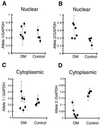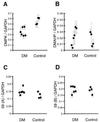Transcriptional abnormality in myotonic dystrophy affects DMPK but not neighboring genes
- PMID: 9207102
- PMCID: PMC23832
- DOI: 10.1073/pnas.94.14.7394
Transcriptional abnormality in myotonic dystrophy affects DMPK but not neighboring genes
Abstract
Myotonic dystrophy (DM) is caused by the expansion of a trinucleotide repeat, CTG, in the 3' untranslated region of a protein kinase gene, DMPK. We set out to determine what effect this expanded repeat has on RNA processing. The subcellular fractionation of RNA and the separate analysis of DMPK transcripts from each allele reveals that transcripts from expanded DMPK alleles are retained within the nucleus and are absent from the cytoplasm of DM cell lines. The nuclear retention of DMPK transcripts occurs above a critical threshold between 80 and 400 CTGs. Further analysis of the nuclear RNA reveals an apparent reduction in the proportion of expansion-derived DMPK transcripts after poly(A)+ selection. Quantitative analysis of RNA also indicates that although the level of cytoplasmic DMPK transcript is altered in DM patients, the levels of transcripts from 59 and DMAHP, two genes that immediately flank DMPK, are unaffected in DM cell lines.
Figures





References
-
- Harper P. Myotonic Dystrophy. London: Saunders; 1989.
-
- Brook J D, McCurrach M E, Harley H G, Buckler A J, Church D, Aburatani H, Hunter K, Stanton V P, Thirion J P, Hudson T, Sohn R, Zemelman B, Snell R G, Rundle S A, Crow S, Davies J, Shelbourne P, Buxton J, Jones C, Juvonen V, Johnson K, Harper P S, Shaw D J, Housman D E. Cell. 1992;68:799–808. - PubMed
-
- Fu Y-H, Pizzuti A, Fenwick R G, King J, Rajnarayan S, Dunne P W, Dubel J, Nasser G A, Ashizawa T, Dejong P, Wieringa B, Korneluk B, Perryman M B, Epstein H F, Caskey C T. Science. 1992;255:1256–1258. - PubMed
-
- Mahadevan M, Tsilfidis C, Sabourin L, Shutler G, Amemiya C, Jansen G, Neville C, Narang M, Barcelo J, Ohoy K, Leblond S, Earle-Macdonald J, Dejong P J, Wieringa B, Korneluk R G. Science. 1992;255:1253–1255. - PubMed
-
- Carango P, Noble J E, Marks H G, Funanage V L. Genomics. 1993;18:340–348. - PubMed
Publication types
MeSH terms
Substances
LinkOut - more resources
Full Text Sources
Other Literature Sources

